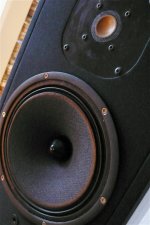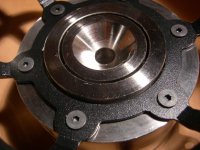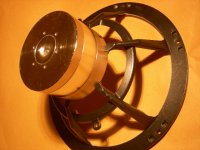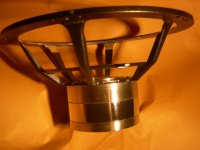STAY AWAY OF ALNICOs
Hi boys,
I agree, all types of ALNICO are obsolete, they are expensive, have less power than neodymium, need a special project on cone/suspension,
need recharge after 15 years or so.
Alnico types magnets have just one good thing, the sound is good, I can say the sound is just better than a good ouput tube(full of harmonics),
the ferrite(Barium or Stroncium etc) and NEO magnets are like cold transistors to my ears.
Stay away of ALNICOs, they are a dangerous Mermaid, a expensive Siren, his sound is the most beautiful and real addictive.
Hi boys,
I agree, all types of ALNICO are obsolete, they are expensive, have less power than neodymium, need a special project on cone/suspension,
need recharge after 15 years or so.
Alnico types magnets have just one good thing, the sound is good, I can say the sound is just better than a good ouput tube(full of harmonics),
the ferrite(Barium or Stroncium etc) and NEO magnets are like cold transistors to my ears.
Stay away of ALNICOs, they are a dangerous Mermaid, a expensive Siren, his sound is the most beautiful and real addictive.

Last edited:
Alnico - Wikipedia, the free encyclopedia See Paragraph 1 in the 'Properties' section.
http://www.magnetsales.com/Alnico/Al1.htm -see Paragraph 4
http://www.dextermag.com/Magnetization-Demagnetization.aspx
http://www.magnetsales.com/Alnico/Al1.htm -see Paragraph 4
http://www.dextermag.com/Magnetization-Demagnetization.aspx
Last edited:
Hi boys,
Alnico types magnets have just one good thing, the sound is good, I can say the sound is just better than a good ouput tube(full of harmonics),
the ferrite(Barium or Stroncium etc) and NEO magnets are like cold transistors to my ears.
I don't understand this. The only thing about a magnet that affects the sound is how much flux density it creates in the gap. Or am I wrong? Let's say you have an experiment. 3 identical speakers but have one use AlNiCo, one use Neo and one use Ferrite. Make sure each magnet produces the same flux in the gap, let's say .9T (the sizes of the magnets will differ.)
There should be no difference in the sound. I don't see how there could be. Am I missing something obvious?
3 identical speakers but have one use AlNiCo, one use Neo and one use Ferrite. Make sure each magnet produces the same flux in the gap, let's say .9T (the sizes of the magnets will differ.)
There should be no difference in the sound.
The Lowther PM6C and PM6A would seem to meet your requirements. Plenty of folks hear a substantial sonic difference. There are enough of them that I am inclined to believe it. I sure wish I had them to compare for myself.
Could it be that the current passing through the coil affects the different materials flux differently? That is the first non-obvious difference that comes to my mind. I know a magnetics guru who has theories about such things, but he isn't inclined to share. I probably wouldn't either. Luckily, I don't know any information worth keep to myself!
Paul
Wild Burro Audio Labs - DIY Full Range Speakers
There are many different properties of magnetics. AlNiCo happens to have properties that tend to be very good for sonics. AlNiCo tends to have less issues with Flux Modulation, is less susceptible to thermal variation, but can be overloaded and lose strength. It's also got better thermal and electrical conductivity than Ferrite.
Neodymium is a different mix with it's own advantages and drawbacks.
Ferrite loses strength as it heats, which is a major problem in high continuous output situations, and something of a problem with even higher home playback levels.
Spend some archive time, this has been discussed ad nauseum. And, look at Barkhausen Noise, which is said to effectively act as a quantization system, lowering potential resolution of simple ferrite motors.
Neodymium is a different mix with it's own advantages and drawbacks.
Ferrite loses strength as it heats, which is a major problem in high continuous output situations, and something of a problem with even higher home playback levels.
Spend some archive time, this has been discussed ad nauseum. And, look at Barkhausen Noise, which is said to effectively act as a quantization system, lowering potential resolution of simple ferrite motors.
Hi Scott,Alnico - Wikipedia, the free encyclopedia See Paragraph 1 in the 'Properties' section.
Alnico Magnets -see Paragraph 4
Dexter Magnetic Technologies
Sorry my obscurecense in this MagnetSales link subject:
What Room Temperature have to do with a magnet?
I do not understand the part: ''Approximately 90% of room temperature magnetization is retained at temperatures of up to 1,000 F.''
Looks room temperature have to do with sound quality or Iam wrong??
The varnish C37 site also talk in ambient temperature!! C37 Acoustics Dieter Ennemoser - Violin Maker & Acoustic Researcher
Thanks in advance for any tip, Gustavo
Last edited:
Basicly, farraday shortrings were invented and used when designers were forced to use ceramic instead of alnico
Alnicos didnt need that
Some have claimed that ceramic with all the possible tricks works just as well as alnico, without the drawbacks
JBL have raised the question, how does alnico work if all the tricks develloped with ceramics are implemented into alnico design
Facts
Alnico is the strongest magnet, in terms of magnetising
They are increased by the length, thus gives more open back
Neo comes close in terms of strength, and also gives open back
Ceramic a bit behind on every
But any of above comes in different qualities, dont forget that
Regarding alnico, some few may still use highest quality, but very expencive
But most would probably use cheaper low grade alnico
You can actually find alnico magnets on exstremely cheap drivers
In the end, you dont even know if they are just faked "look-alikes"
Alnicos didnt need that
Some have claimed that ceramic with all the possible tricks works just as well as alnico, without the drawbacks
JBL have raised the question, how does alnico work if all the tricks develloped with ceramics are implemented into alnico design
Facts
Alnico is the strongest magnet, in terms of magnetising
They are increased by the length, thus gives more open back
Neo comes close in terms of strength, and also gives open back
Ceramic a bit behind on every
But any of above comes in different qualities, dont forget that
Regarding alnico, some few may still use highest quality, but very expencive
But most would probably use cheaper low grade alnico
You can actually find alnico magnets on exstremely cheap drivers
In the end, you dont even know if they are just faked "look-alikes"
Last edited:
can be the same as opt trafo ? permalloyd- amorphous react better on small signal......
quote from
http://www.diyaudio.com/forums/tubes-valves/127666-core-sonic-reasons.html#post1579331
"what (nikel) the pinstriping does for you--- is that at very low drive levels.
especially in the case of M6 is that at very low flux density levels-- the nickel exhibits greater permeability-- so that it "jump starts" easier than M6."
quote from
http://www.diyaudio.com/forums/tubes-valves/127666-core-sonic-reasons.html#post1579331
"what (nikel) the pinstriping does for you--- is that at very low drive levels.
especially in the case of M6 is that at very low flux density levels-- the nickel exhibits greater permeability-- so that it "jump starts" easier than M6."
Yes, you indicate another aspect/issue
The quality of the steel used fore poleplates
Next issue , poleplate design
And quality of machining the poleplates, assembling accuracy etc
"Handmade" proto type may be ok, but the actual resulting product much different
And measurements might deviate a lot from prototype, if done at all, or published
A lot of issues
You know, its possible to make an old vintage motorcycle like a Norton Commando into a perfect modern competitive bike, just by changing bits and pieces, with better materials and tolerances
The quality of the steel used fore poleplates
Next issue , poleplate design
And quality of machining the poleplates, assembling accuracy etc
"Handmade" proto type may be ok, but the actual resulting product much different
And measurements might deviate a lot from prototype, if done at all, or published
A lot of issues
You know, its possible to make an old vintage motorcycle like a Norton Commando into a perfect modern competitive bike, just by changing bits and pieces, with better materials and tolerances
Last edited:
how do you bond a flat poleplate to a distorted ceramic magnet?Next issue , poleplate design
And quality of machining the poleplates, assembling accuracy etc
how do you bond a flat poleplate to a distorted ceramic magnet?
I suppose that is part of the quality aspect, but good point
Optimally there shouldnt be any use of glue, or more realistically only very moderately
Plating is probably not good either, but needed against corrosion
Big question is whether we will actually hear any difference
Or whether we are skilled enough to "exstract" the advantages into the finished speaker design
Last edited:
Basicly, farraday shortrings were invented and used when designers were forced to use ceramic instead of alnico
Alnicos didnt need that
Some have claimed that ceramic with all the possible tricks works just as well as alnico, without the drawbacks
JBL have raised the question, how does alnico work if all the tricks develloped with ceramics are implemented into alnico design
Facts
Alnico is the strongest magnet, in terms of magnetising
They are increased by the length, thus gives more open back
Neo comes close in terms of strength, and also gives open back
Ceramic a bit behind on every
But any of above comes in different qualities, dont forget that
Regarding alnico, some few may still use highest quality, but very expencive
But most would probably use cheaper low grade alnico
You can actually find alnico magnets on exstremely cheap drivers
In the end, you dont even know if they are just faked "look-alikes"
You say the Alnico is the strongest magnet.
I have designed a 8" series where I have made samples with Neo N52, Neo N35, Alnico and ferrite magnets.
All magnets are identical in size.
Alnico are a pussycat in regard of strenght comparred with Neo.
The price for Alnico and Neo N35 are identical.
The Neo N52 are twice as expensive.
Ferrite are extremely cheap and have a cost of 1/70 of the Neo N52.
I have designed a complete 8" driver - magnetsystem, cones (1 and 2 layer) with silk surrounds (both cone and surround are my own design), dustcap, voicecoils.
I have been using modified Seas 22cm baskets, but will cast my own baskets shortly.
The 8" drivers are spiderless and uses ferrofluid, the magnet gap are 24mm, and voicecoils are copper 6mm (2 layer) and 10mm (single layer) with Nomex bobbin.
Attached a picture of the two layer cone with silk surround mounted in a Impulse H2 horn speaker.
Attachments
You say the Alnico is the strongest magnet.
All magnets are identical in size.
Alnico are a pussycat in regard of strenght comparred with Neo.
Then you have approached it wrong, sorry
Its not about size, but how high you can push it, and alnico and neo ends about the same
I think the possible limit is close to 2 Tesla (?), probably because the Pole iron saturates
Ceramic have never reached that, neo is close
But alnicos being way bigger in size
You will find the specs on Lowthers http://www.lowtherloudspeakers.co.uk/homeindex.html
But your 8" sounds really interesting, looks really good
Last edited:
Then you have approached it wrong, sorry
Its not about size, but how high you can push it, and alnico and neo ends about the same
I think the possible limit is close to 2 Tesla (?), probably because the Pole iron saturates
Ceramic have never reached that, neo is close
But alnicos being way bigger in size
But your 8" sounds really interesting, looks good
Yes - I know that Alnico need the length, but when I designed my magnet system it was with Neo in mind.
I made some samples with Alnico and ferrite just to have something to measure and compare (if I needed).
Attached some pictures of the magnetsystem.
Attachments
Basicly, farraday shortrings were invented and used when designers were forced to use ceramic instead of alnico
Alnicos didnt need that
Some have claimed that ceramic with all the possible tricks works just as well as alnico, without the drawbacks
JBL have raised the question, how does alnico work if all the tricks develloped with ceramics are implemented into alnico design
Regardless of the magnet used (Neo, Alnico, ferrite) in my magnet systems all the tricks I found usefully have been included.
Just to mention some of the tricks - there are farraday shortrings made of stainless steel both on the inside of the magnet ring and on the outside of the T-yoke - the magnet system are vented..
The question asked by JBL have been tested and Seas have included all the tricks they have ever used in their Exotic Alnico series and in my magnet systems I have included even more "tricks".
It is only a question of cost----
Last edited:
- Status
- This old topic is closed. If you want to reopen this topic, contact a moderator using the "Report Post" button.
- Home
- Loudspeakers
- Full Range
- alnico`s 8 inch



